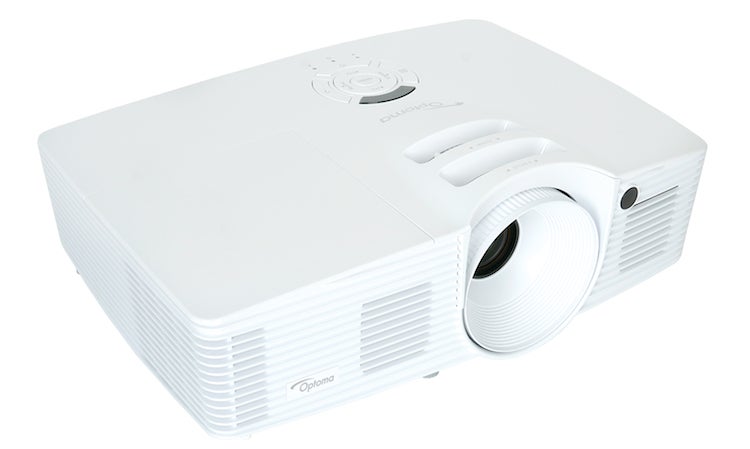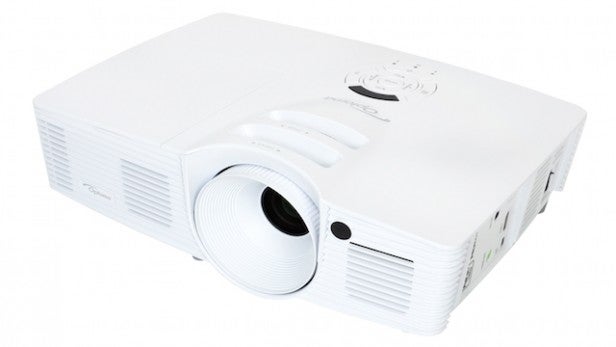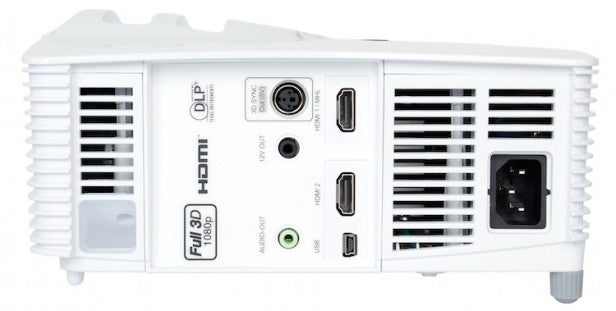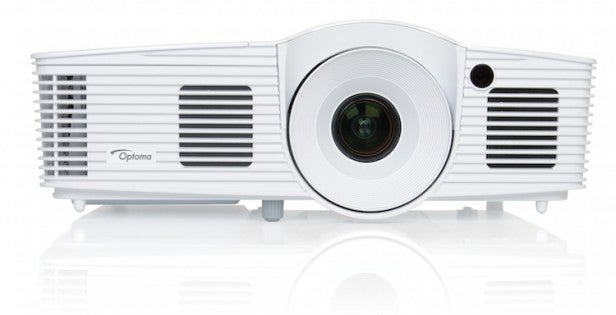Optoma HD28DSE Review
Optoma HD28DSE
Optoma brings serious video processing to the affordable projector market

Sections
- Page 1 Optoma HD28DSE Review
- Page 2 Picture Quality Review
- Page 3 3D, Sound and Conclusions Review
Verdict
Pros
- Darbee processing adds remarkable sharpness and detail
- Strong colour performance
- Low input lag for gaming
Cons
- Darbee processing is "labour-intensive"
- Clumsy dynamic black system
- Limited zoom range and rainbow effect could be problems for some
Key Specifications
- Review Price: £699.00
- Single-chip DLP projector
- Full HD native resolution
- Darbee video-processing engine
- Powered USB port
- 3,000 lumens claimed brightness
What is the Optoma HD28DSE?
At first glance the £699 Optoma
HD28DSE looks just like any other member of the increasingly crowded
budget projector marketplace. However, it hides a neat feature up its
sleeves: award-winning DarbeeVision video processing, which claims to be
capable of improving image depth, clarity, object separation and
realism. But can such a seemingly powerful image-processing system
really be compatible with such an affordable projector?
Optoma HD28DSE – Design and Features
Optoma
has a knack for making attractive projectors, and the HD28DSE continues
the trend. Its cool all-white exterior and bold combination of angles
and curves give it plenty of coffee table appeal.
SEE ALSO: Best Projector 2015
While
those wanting to place the HD28DSE in a dedicated movie room may have
preferred a black finish, in most cases I see the affordable Optoma
being used on an ad hoc basis in a living room.
Down the
HD28DSE’s side sit a decent suite of connections. Highlights include two
HDMIs (version 1.4a types with 3D and MHL support); a powered USB port
capable of supporting dongles such as the Amazon Fire and Google Chromecast;
an audio output; a 12v trigger port for, say, firing up a connected
motorised screen; and a circular port for attaching an optional 3D sync
transmitter. You can also add wireless HDMI functionality via Optoma’s
optional (£180) WHD200 pack.
To make use of the HD28DSE’s 3D abilities you’ll need to invest in 3D glasses – predictably, none are included for the projector’s £699 price.
The HD28DSE delivers its pictures using a single-chip DLP system, claimed to be capable of pumping out a huge 3,000 lumens of brightness and an unexpectedly high 30,000:1 contrast ratio.
Note, though, that this contrast figure is based on a “Dynamic Black” feature that adjusts light output in response to the image content. This is a process that can result in light instability issues if it isn’t handled well. This is especially likely if partnered with the sort of extreme brightness the HD28DSE can apparently deliver.
The practical benefit of the Dynamic Black feature is that it delivers a claimed 8,000 hours of life from the HD28DSE’s lamp. That’s an impressive figure for such a bright, affordable projector – and it means that, even if you watch a movie every day, it could last you up to 10 years.
The HD28DSE’s biggest selling point, though, is its DarbeeVision Visual Presence video-processing system.
This processing engine claims to use neuro-biologic algorithms to enhance the detail and depth of skin tones, textures and reflective surfaces, resulting in a boost to the image’s clarity.
You can choose between three modes: “Hi-Def” is the least aggressive, and is recommended for high-quality content such as Blu-rays; “Gaming” mode is suited to computer generated images; and finally, the brilliantly named “Full Pop” mode, designed for low-resolution and/or low-quality video sources. 
Given that I love a good neuro-biologic algorithm as much as the next man, I’m intrigued to discover what the Darbee engine can do. Especially given that the inclusion of such as video-processing engine in a projector costing under £700 is practically unheard of.
Optoma HD28DSE – Setup
When it comes to physical setup tools, the HD28DSE is disappointing. It offers only a token amount of optical zoom, and – more predictably for its money – there isn’t any optical image shifting in either a vertical or horizontal direction.
Depending on your room layout, getting the required image size could be tricky. And it could even result in you having to resort to the projector’s digital keystone adjustments to get the edges of the image looking perpendicular. This isn’t ideal, digital keystone adjustments essentially distort the image, detracting from the pixel to pixel accuracy with HD sources you’d otherwise get from the HD28DSE.
The HD28DSE fairs better with its menu setup options. There’s a decent degree of colour management, which extends to the secondary as well as primary colours, and there’s also a solid selection of picture presets for different types of content and room setup.
Of these the most useful are Reference, which essentially turns off all the fancy stuff to deliver a classic Rec 709 picture and Cinema. The Cinema setting uses tricks such as DLP Brilliant Colour, the Darbee engine and the Dynamic Black feature to deliver a markedly more eye-catching image. 
You need to handle the HD28DSE’s picture tools with care, however. Where Darbee is concerned, I’d recommend against using the Full Pop setting for reasons I’ll discuss in the next section.
With the Hi-Def setting, tedious though it sounds, I’d adjust its level of operation depending on how grainy the Blu-ray or DVD you’re watching is. You can leave it at its default 80 level for a pristine Blu-ray transfer such as Oblivion, but for grainy titles such as 300 and the final Harry Potter film you’ll need to reduce the setting to below 50.
Throughout testing, the Gaming mode seemed just fine using its default setting – just remember to switch away from it when you go back from gaming to watching a film.
Rather reluctantly, my final piece of advice is that you turn off the Dynamic Black function, for reasons I’ll cover in the next section.

